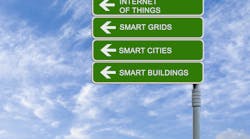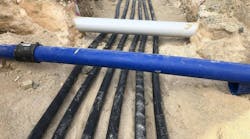Four strategies can leverage geospatial technology to help utilities manage their business:
- Understand business and investment uncertainty
- Deal with competitive pressures head on
- Create a stakeholder collaboration culture: individuals, microgrids, and major providers
- Coordinate planning on a wider scale
Understand Business and Investment Uncertainty
For decades utilities have fine-tuned their investment strategies. They forecasted demand. They studied their assets. They poured over their income statements, cash flow and balance sheets. They then balanced their investments. They looked at shareholder return, customer service, regulatory compliance, and employee and community safety. Not easy for sure. But it worked.
Today, utilities must learn to lead in the new energy environment. The prosumer has emerged — the customer that both receives and produces energy. No longer is demand so easy to determine. Utilities will use location intelligence from geographic information systems (GIS). GIS is a technology they’ve relied on for decades to map, manage, and analyze all aspects of their network. GIS helps utilities understand demographics, hazards, climate change impacts, and where competition is most likely to occur and when.
Smart utility executives will offer new services to these prosumers. Some utilities may sell access to the grid and even help neighborhoods with solar panels and other sources of distributed energy from a microgrid.
Utilities must learn how to disrupt their own business model. Some need to stimulate and harness distributed energy resources (DERs). Some may divest of power generation altogether (some already have) and hold onto the transmission and distribution lines — their version of the internet. Others may become retailers. They will buy and sell power without owning lines or the means of generating electricity.
Deal with Competitive Pressures Head On
Utilities will need to know the locations of DERs. They will need to know how much energy they can produce, and how much they may need. GIS — the technology that, for decades, has helped utilities map their assets — can assist in the process. Utilities can use GIS to map DERs and provide real-time data on power production and energy needs. Much of that information will come from the IoT-connected sensors that utilities are adding to the grid.
IoT-connected data sensors will certainly help. Not only is the data from the devices important, but also their location. They will communicate across power networks. Providers can identify peak demands and unexpected usage trends. They can locate prosumers who have excess power. Utilities can broker what can be bought, sold, and redistributed.
Utilities have used GIS for years. They have used GIS to locate assets such as transmission lines, substations, vehicles, and service personnel. Now that same GIS can pinpoint the location of customers, prosumers, and microgrids. It can monitor fluctuations in consumption and production within those networks. With sensors, GIS can even track the health of every solar panel or storage system at a house or business.
Market dynamics is changing quickly. Prosumers turn to solar power to save money. They seek to sell their excess power. GIS can run ongoing analysis. It can monitor power consumption over time along with local weather patterns to predict future usage and needs.
As IoT improves data communication, utilities can leverage GIS for vital information about all aspects of the power grid.
Create a Stakeholder Collaboration Culture: Individuals, Microgrids, and Major Providers
Consumers, producers, distributors, and prosumers must collaborate to meet their individual energy needs. Even as battery storage improves, it will be difficult for an individual or microgrid to generate and store enough power to be self-sufficient. Prosumers will see value in paying to connect to the major power grid. This will assure an uninterrupted supply of electricity. This will keep homes and businesses running when storms or clouds obscure the sun, or when other renewable sources aren’t available.
There will be days or weeks when storage batteries are fully charged. Solar panels produce surplus electricity that can be sold for profit and used to support peak demands or urgent needs. Transmitting surplus energy to places in need of power will keep commerce from being disrupted and reduce equipment problems caused by blackouts or brownouts.
Collaboration among multiple parties in the utility network, including DERs, can be facilitated by GIS. User-friendly visual displays and real-time mapping will give everyone involved a view of changing energy demands and resources. The utility that owns the grid then becomes the broker between those with surplus and those with needs.
In Vermont, a community of modular homes fitted with solar panels and storage capabilities was able to save money for its residents and the local utility. With strong collaboration and communication, the utility draws on charged solar batteries in homes to create a virtual power plant that kicks in during periods of high demand. Solar panels and batteries lessened the community’s need to take energy from the grid during peak periods and created a savings of US$200,000.
Utilities can set connection fees based on:
- The amount of power needed
- The amount produced and sent to the grid
- The number of times a home or business needs to connect, or
- The total sales by an individual or entity.
With more retailers packaging energy, and buying and selling DERs, the connection to the grid — and the collaboration possible through GIS — becomes ever more valuable. Collaboration also means that utilities can serve as brokers and take a commission on each transaction.
The market is still developing. Utilities may find that the growth of microgrids and DERs offers opportunities to save money. More microgrids means less demand on the central power plant, and fewer investments in capital improvements. For example, if a storm knocks down transmission lines, many microgrids are likely to continue operating, which means the utility can dispatch fewer service personnel to deal with emergency repairs.
Coordinate Planning on a Wider Scale
A utility needs to know what’s going on with prosumers as well as large systems such as government entities and businesses that could affect power availability.
Coordination refers to the ability to plan in conjunction with other large-scale operations — including planning and responding to long-term trends and real-time situations. A utility needs to know about development plans. They need to predict growth patterns of cities, neighborhoods, business parks, and shopping or entertainment districts. That data resides at city and county zoning and planning departments. Those plans and proposals often affect decisions about where to expand the power grid or how to manage energy resources.
GIS can act as a shared repository of that information. This makes it easy for all parties to plans and coordinate. When done in harmony, the results can be like that of a community of 2900 homes being built in Arizona that will generate much of its own power through solar. The community can leave or join the local utility grid as needed. When the local utility sells power at a lower rate, the community will buy it as needed to keep batteries fully charged.
Electric cars account for only about 2% of all registered vehicles. Yet several companies and utilities see opportunity in the rechargeable batteries that typically sit idle most of the day. The concept is known as vehicle-to-grid or V2G. Nissan, for one, is already working with a partner to produce a smart charging station that will let owners of electric cars put energy back on the grid. By charging batteries during non-peak hours and selling energy back during high-demand periods, owners may cover the cost of charging their batteries.
For long-term planning, GIS can provide insight on population trends and residential patterns or changes at street level. A utility, for instance, does not want to dig up streets to maintain its assets right after the city repaves the roadway. A shared GIS database helps both sides coordinate work.
Coordination also happens in real time by sharing information with emergency management departments. Utilities will learn of potential power disruptions due to natural disasters or accidents. By consulting GIS, the utility or retail energy provider can locate impacted transmission lines and substations to see which consumers will be affected by an outage. They can share information with emergency services providers and coordinate the best course of action.
The Future
DERs and the prosumers associated with them continue to grow in number. Financial analysts predict that microgrids’ share of the market will increase by 19% between 2017 and 2024. Then it will be worth US$19 billion. As the energy market changes, utilities will explore many business models. Traditional utilities will have to monetize connections to the grid instead of simply selling power as a commodity.
Utilities will look to consumer demographics and growth patterns — data visible with GIS — to predict future needs. GIS will also help providers customize offerings for residents with solar panels and those who prefer to buy renewable energy.
If today’s power provider doesn’t learn to harness location intelligence from GIS to serve the changing needs of prosumers, then other innovative businesses certainly will.
Bill Meehan is a member of T&D World's Executive Insighs board.


